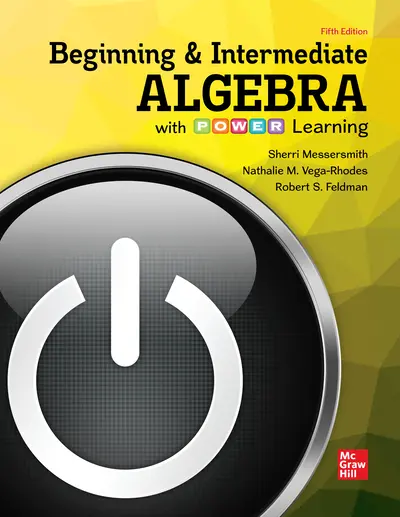My Account Details

ISBN10: 126009751X | ISBN13: 9781260097511

* The estimated amount of time this product will be on the market is based on a number of factors, including faculty input to instructional design and the prior revision cycle and updates to academic research-which typically results in a revision cycle ranging from every two to four years for this product. Pricing subject to change at any time.
Instructor Information
Quick Actions (Only for Validated Instructor Accounts):
The 5th edition of Beginning and Intermediate Algebra by Sherri Messersmith and Nathalie Vega-Rhodes represents the most evolved version of the P.O.W.E.R. series textbooks yet. To each chapter we have added a new Get Ready chapter opener that contains prerequisite/corequisite lessons, with exercises, to prepare students to learn the concepts coming up in the chapter. Also new to this edition are the two academic mindset topics of developing a growth mindset and developing grit. The power (no pun intended) of the Internet is that it allows us to enhance the learning and teaching experience for students and instructors. We can do things that we couldn’t dream of even 10 years ago! That’s where Nathalie Vega-Rhodes comes in. A long-time P.O.W.E.R. math textbook user and outstanding instructor, Nathalie has a lot of experience using digital tools. Better yet, she and Sherri have the same philosophy of teaching, love for students, and belief in addressing all of their students’ needs in the classroom.
What makes P.O.W.E.R. a unique tool for the classroom? A major challenge in developmental courses is that students at this level struggle with basic study skills and habits. Maybe this is one of their first college courses or perhaps they are adults returning to school after a long absence. Either way, many of the individuals taking this course don’t know how to be good students. Instructors often don’t have the time, the resources or the expertise to teach success skills AND the math concepts. The P.O.W.E.R. Learning Framework was developed by successful author, psychologist, student success instructor and researcher, Bob Feldman. It is a method of accomplishing any task using five simple and consistent steps. Prepare. Organize. Work. Evaluate. Rethink. The P.O.W.E.R. framework that Math instructors have come to know and love is at the core of each section and new study strategies and exercises have been integrated with every chapter better help students successfully learn math concepts while at the same time developing habits that will serve them well throughout their college careers and in their daily lives. The conversational writing style, practical applications, innovative student resources and expanded available in ALEKS makes this an appealing and very teachable option for faculty.
Chapter 2 Rules of Exponents
Chapter 3 Linear Equations and Inequalities in One Variable
Chapter 4 Linear Equations in Two Variables and Functions
Chapter 5 Solving Systems of Linear Equations
Chapter 6 Polynomials
Chapter 7 Factoring Polynomials
Chapter 8 Rational Expressions
Chapter 9 More Equations and Inequalities
Chapter 10 Radicals and Rational Exponents
Chapter 11 Quadratic Equations
Chapter 12 Functions and Their Graphs
Chapter 13 Exponential and Logarithmic Functions
Chapter 14 Conic Sections, Nonlinear Systems, and Nonlinear Inequalities
Chapter 15 Sequences and Series (online only)
Appendix A Prealgebra Topics (online only)
Appendix B Beginning Algebra Review (online only)
Appendix C Additional Topics (online only)
Accessibility
Creating accessible products is a priority for McGraw Hill. We make accessibility and adhering to WCAG AA guidelines a part of our day-to-day development efforts and product roadmaps.
For more information, visit our accessibility page, or contact us at accessibility@mheducation.com
Need support? We're here to help - Get real-world support and resources every step of the way.